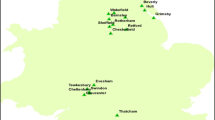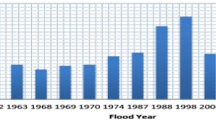Abstract
This study presents the results of open-ended contingent valuation method (CVM) to estimate the residents’ maximum willingness to pay (WTP) for flood insurance and structural flood control measures in the Neka River Basin in Northern Iran. Flood inundation analysis and floodplain risk mapping were conducted by applying the HEC-RAS model combined with GIS analysis. A calibrated 100-year flood risk inundation map was considered as a basis for this research. This paper demonstrates applicability of CVM combined with flood inundation analysis to understand public participation for flood risk management, and their perception of flooding, considering associated socioeconomic and environmental factors. The results have shown that stated WTPs significantly varies with household income, distance people live from the river and the land use type of properties. Findings of this study suggest that the majority of respondents view flood hazard as the most important natural disaster. Furthermore, WTPs are significantly higher for those who have high level of flood risk perception. Three policy options for flood risk management are discussed, which include flood zoning and land use regulation, flood insurance program, and structural measure of levee construction. The advantages and disadvantages of each option are explored. It was concluded that a combination of possible mitigation options should be considered in order to achieve sustainable flood risk management in the Neka River Floodplain.



Similar content being viewed by others
References
Adelekan IO (2011) Vulnerability assessment of an urban flood in Nigeria: Abeokuta flood 2007. Nat Hazards 56:215–231. doi:10.1007/s11069-010-9564-z
Alberini A, Kahn J (2006) Handbook on contingent valuation. Edward Elgar, Cheltenham, p 448
Blanchard-Boehm RD, Berry KA, Showalter PS (2001) Should flood insurance be mandatory? Insights in the wake of the 1997 New Year’s Day flood in Reno–Sparks, Nevada. Appl Geogr 21:199–221. doi:10.1016/S0143-6228(01)00009-1
Burby RJ (2001) Flood insurance and floodplain management: the US experience. Environ Hazards 3:111–122. doi:10.1016/S1464-2867(02)00003-7
Carson R, Flores N, Hanemann M (1998) Sequencing and valuing public goods. J Environ Econ Manag 36:314–323. doi:10.1006/jeem.1998.1050
Clark DE, Novotny V, Grifin R, Booth D, Bartosova A, Daun MC, Hutchinson M (2002) Willingness to pay for flood and ecological risk reduction in an urban watershed. Water Sci Technol 45(9):235–242
Dawson RJ, Ball T, Werritty J, Werritty A, Hall JW, Roche N (2011) Assessing the effectiveness of nonstructural flood management measures in the Thames Estuary under conditions of socio-economic and environmental change. Glob Environ Chang 21:628–646. doi:10.1016/j.gloenvcha.2011.01.013
Duram LA, Brown KG (1999) Assessing public participation in U.S. watershed planning initiatives. Soc Nat Resour 12:455–467
Ghanbarpour MR, Hipel KW, Abbaspour KC (2005) Prioritizing long-term watershed management strategies using group decision analysis. Int J Water Resour Dev 21(2):297–309. doi:10.1080/07900620500108528
Ghanbarpour MR, Mohseni Saravi M, Salimi S, Hajiseyedjavadi ST, Zarei M (2010) Innovative method for flood insurance assessment using hydraulics simulation and contingent valuation. Technical Report: Iran National Science Foundation, 125 pp
Ghanbarpour MR, Salimi S, Mohseni Saravi M, Zarei M (2011a) Calibration of river hydraulic model combined with GIS analysis using ground-based observation data. Res J Appl Sci Eng Technol 3(5):456–463
Ghanbarpour MR, Sajjadi S, Hajiseyedjavadi ST, Chen X (2011b) Investigation of visitors’ participation and willingness to pay for the Baba Aman recreational park, Iran. Res J Environ Earth Sci 3(6):722–728
Ghanbarpour MR, Salimi S, Hipel KW (2013) A comparative evaluation of flood mitigation alternatives using GIS‐based river hydraulics modelling and multicriteria decision analysis. J Flood Risk Manag 6:319–331. doi:10.1111/jfr3.12017
Godden L, Kung A (2011) Water law and planning frameworks under climate change variability: systemic and adaptive management of flood risk. Water Resour Manag 25:4051–4068. doi:10.1007/s11269-011-9887-x
Griffin C, Briscoe J, Singh B, Ramasubban R, Bhatia R (1995) Contingent valuation and actual behaviour: predicting connections to new water systems in the state of Kerala, India. World Bank Econ Rev 9(3):373–395
Hydrologic Engineering Center (HEC) (2010) HEC-RAS river analysis system. Hydraulic reference manual (version: 4.1). U.S. Army Corps of Engineering, Davis, 262 pp
Kron W (2009) Flood insurance: from clients to global financial markets. J Flood Risk Manag 2:68–75. doi:10.1111/j.1753-318X.2008.01015.x
Kundzewicz ZW, Hirabayashi Y, Kanae S (2010) River floods in the changing climate—observations and projections. Water Resour Manag 24:2633–2646. doi:10.1007/s11269-009-9571-6
Kunreuther HC, White GF (1994) Flood hazard delineation: the one percent standard. Water Resour Updat 95:31–35
Montgomery DR, Grant GE, Sullivan K (1995) Watershed analysis as a framework for implementing ecosystem management. Water Resour Bull 31:369–386
Thunberg E, Shabman L (1991) Determinants of landowner’s willingness to pay for flood hazard reduction. Water Resour Bull 27(4):657–665
Treby EJ, Clark MJ, Priest SJ (2006) Confronting flood risk: implications for insurance and risk transfer. J Environ Manag 81:351–359. doi:10.1016/j.jenvman.2005.11.010
Wang Y, Li Z, Tang Z, Zeng G (2011) A GIS-based spatial multi-criteria approach for flood risk assessment in the Dongting lake region, Hunan, Central China. Water Resour Manag 25:3465–3484. doi:10.1007/s11269-011-9866-2
Wei Y, Davidson B, Chen D, White R, Li B, Zhang J (2007) Can contingent valuation be used to measure the in situ value of groundwater on the north China plain? Water Resour Manag 21:1735–1749. doi:10.1007/s11269-006-9123-2
Whittington D (1998) Administering contingent valuation surveys in Developing Countries. World Dev 26(1):21–30
Zhai G, Sato T, Fukuzono T, Ikeda S, Yoshida K (2006) Willingness to pay for flood risk reduction and its determinants in Japan. J Am Water Resour Assoc 42:927–940. doi:10.1111/j.1752-1688.2006.tb04505.x
Acknowledgments
This study has been supported by the Iran National Science Foundation (INSF), research project No. 85075/38, for which the authors are very grateful. The authors wish to thank all residents who devoted their time for taking part in the interviews and filling in the questionnaires. The authors also would like to thank Mr. Mehdi Zarei and Mrs. Tahereh H. Javadi for their great cooperation in conducting the survey and interviews. The authors appreciate the editing of their manuscript carried out by Ms. Teresita Romero at Trinity College, CT, United States. The authors would like to thank the anonymous reviewers for their helpful comments.
Author information
Authors and Affiliations
Corresponding author
Rights and permissions
About this article
Cite this article
Ghanbarpour, M.R., Saravi, M.M. & Salimi, S. Floodplain Inundation Analysis Combined with Contingent Valuation: Implications for Sustainable Flood Risk Management. Water Resour Manage 28, 2491–2505 (2014). https://doi.org/10.1007/s11269-014-0622-2
Received:
Accepted:
Published:
Issue Date:
DOI: https://doi.org/10.1007/s11269-014-0622-2




